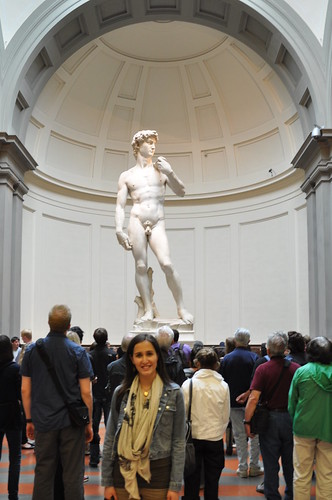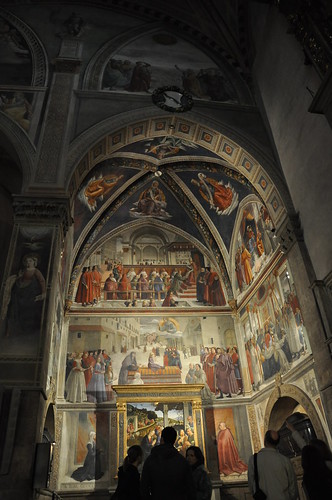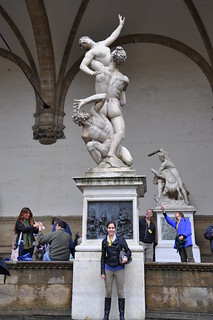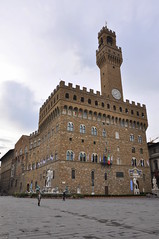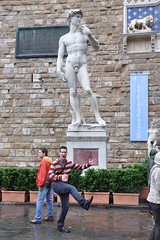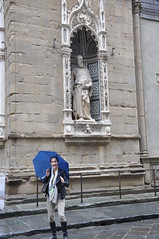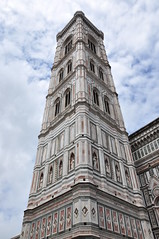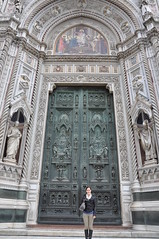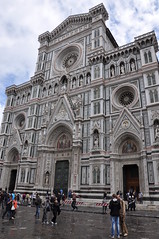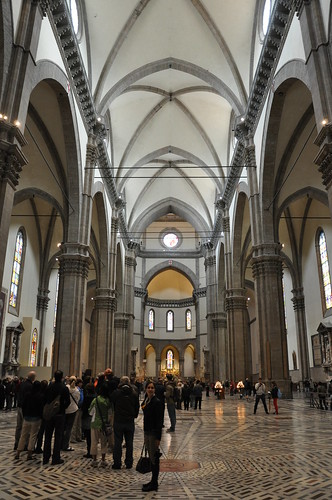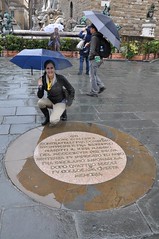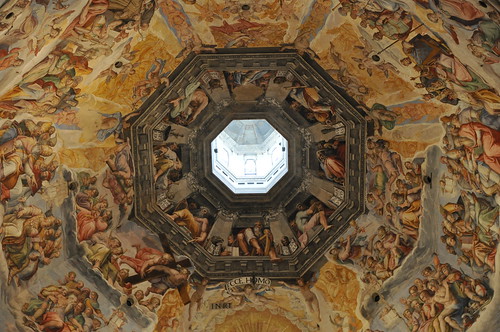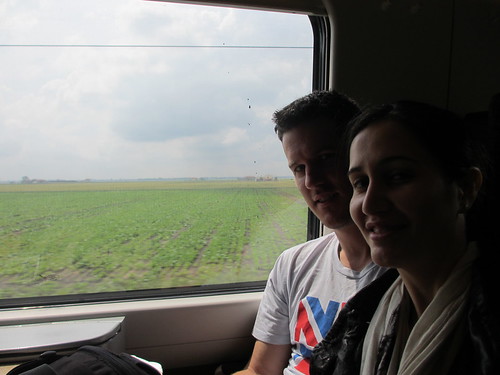Lonely Planet called Florence an essential stop on everyone’s Italian itinerary. We completely agree. The Renaissance architecture, statues and art is wonderful and everywhere and overwhelming. We had a fantastic few days.
One of the highlights of our trip was seeing the statue of David at the Galleria dell’ Accademia. Hindsight is 20/20, but I *strongly* recommend you reserve tickets before you go here or to the Uffizi Gallery. We ended up waiting 2 hours to see David. We should’ve just paid the extra for reserving on the day, but such is life. So book your tickets people!
Thankfully, the statue was worth the wait.
Michelangelo carved David when he was just 29 and it was unveiled in 1504 outside the Palazzo Vecchio. It was moved to the Accademia in 1873 and placed beneath the rotunda of a room built exclusively for the display. The statue, for those who aren’t sure, is of David after he’s beaten Goliath with his slingshot. A beautiful specimen. We snuck a photo while we were there.
We went on a great walking tour while we were in Florence that took us to all the highlights and taught us about the Medici family. The Medici’s were a political dynasty, banking family and later royal house that first began to gather prominence under Cosimo de’ Medici in the late 14th century. They basically owned the Republic of Florence, and their commissioned works and family crest can be found everywhere. (For those who are interested, our walking tour was with Artiviva Italy.)
We were surprised to find out that the whole Uffizi Gallery was bequesthed to the people of Tuscany by the last Medici grand duchness in 1737. The paintings and sculptures had been accumulated by the powerful grand dukes during 3 centuries of rule while the Renaissance was at its peak. Pretty amazing. We couldn’t take any photos in the gallery, but I highly recommend you see it.
Our walking tour took us to one of the oldest churches in Florence – Santa Trinata. The church is famous for its Sassetti Chapel, containing some beautiful frescoes by Domenico Ghirlandaio. They are ranked amongst the 15th century masterworks. They were pretty stunning, even in the dimly lit church.
The frescos are beautiful. The word ‘fresco’ means ‘fresh’ in Italian, because the paint had to be done when the plaster was still wet. The pigment is absorbed by the wet plaster and after a number of hours. When the plaster dries and reacts with the air, the pigment particles are fixed into the plaster.
Francesco Sassetti was a rich banker in the 15th century and a member of the Medici entourage, for which he directed the Medici Bank. He commissioned the execution of the frescoes from the most famed artist of the city, Domenico Ghirlandaio. This scene from the middle panel shows the outside of Santa Trinita’s piazza in the 15th century, with the old Romanesque façade of the church.
Here’s the modern street today, though perhaps we should’ve been standing a bit further back from the church on the right to get the same perspective as the fresco above. Also note the umbrella – it rained for the first 2 days we were in Florence. Poured, in fact. Still a beautiful city.
We also visited Piazza della Signoria and the Loggia della Signoria in it – a 14th century open air gallery of antique and Renaissance sculptures. It has over a dozen amazing works in it and it’s free! Two of the most prominent statues are the bronze statue of Perseus holding Medusa’s head, and the marble kidnapping of a Sabine woman. Both statues are so dramatic and emotive, as well as being huge! (I’m standing below them)
The sculptures are alongside the imposing Palazzo Vecchio – the traditional seat of the Florentine government. In front of the Palazzo Vedchio is where the original Statue of David by Michelangelo used to stand. We were pretty pleased with a reminder of our youth – Michelangelo was a Teenage Mutant Ninja Turtle. We also found a statue by Donatello – a seven foot marble statue of Saint Mark outside the Orsanmichele church. We tried to complete the TMNT set but the Leonardo and Raphael works we saw were in the Uffizi Gallery and we couldn’t take a photo! Ah well.
I apologize for our terrible ninja poses below.
But of course, the highlight of Florence is the phenomenal Il Duomo. The building in the foreground is the 8-sided Baptistry – one of the oldest buildings in the city, built between 1059 and 1128. The architecture is in Florentine Romanesque style and the sides are clad in geometrically patterned colored marble. That’s a lot of marble!
The cathedral complex, located in Piazza del Duomo, includes the Baptistery and Giotto’s Campanile (the bell tower). The three buildings are part of the UNESCO World Heritage Site covering the historic centre of Florence. The cathedral itself is smaller than St Peter’s Basilica (220m vs 153m in length) but because of the closeness of the surrounding square, there is an element of surprise to the vista that opens up once you came out of the small side streets. It’s pretty impressive.
Again, there was a line to get inside, but at least it was free. The Gothic interior is vast and empty. A famous monk in the 15th century who spoke against Pope Alexander VI, Girolamo Savonarola, gave many of his sermons from this cathedral. He said that the relative bareness of the church corresponds with the austerity of religious life.
As a side note, Savonarola defied the Pope by preaching under a ban, highlighting his campaign for religious reform with processions, bonfires of vanities (ie wealth) and pious theatricals. For his defiance, the Pope had him hanged and burned in Florence. We visited the plaque in Piazza della Signoria commemorating the monk’s death.
Back to the Duomo. Grand Duke Cosimo I de’ Medici decided to have the inside of the dome painted with a representation of The Last Judgment. The golden colours in the work is a clear contrast to the starkness of the plain walls. It’s very striking, and 90m above our heads!
Beautiful.
We were thrilled with our few days in Florence. It’s an amazing city with so many museums, churches and streets to wander that we could’ve stayed another week. Easily. Though I have to say we loved all the food in Florence! There were so many restaurants north of Il Duomo that we could choose from, and they were all great. Sliced meat starters, freshly made ravioli, refreshing Prosecco and bracing after-dinner Grappa. Delicious.
Now, we’re off to Venice.
